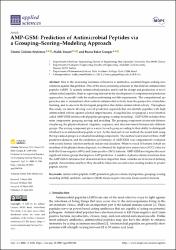| dc.contributor.author | Soylemez, Ummu Gulsum | |
| dc.contributor.author | Yousef, Malik | |
| dc.contributor.author | Bakir-Gungor, Burcu | |
| dc.date.accessioned | 2023-05-26T11:54:44Z | |
| dc.date.available | 2023-05-26T11:54:44Z | |
| dc.date.issued | 2023 | en_US |
| dc.identifier.issn | 2076-3417 | |
| dc.identifier.other | WOS:000979120100001 | |
| dc.identifier.uri | https://doi.org/10.3390/app13085106 | |
| dc.identifier.uri | https://hdl.handle.net/20.500.12573/1605 | |
| dc.description.abstract | Due to the increasing resistance of bacteria to antibiotics, scientists began seeking new solutions against this problem. One of the most promising solutions in this field are antimicrobial peptides (AMP). To identify antimicrobial peptides, and to aid the design and production of novel antimicrobial peptides, there is a growing interest in the development of computational prediction approaches, in parallel with the studies performing wet-lab experiments. The computational approaches aim to understand what controls antimicrobial activity from the perspective of machine learning, and to uncover the biological properties that define antimicrobial activity. Throughout this study, we aim to develop a novel prediction approach that can identify peptides with high antimicrobial activity against selected target bacteria. Along this line, we propose a novel method called AMP-GSM (antimicrobial peptide-grouping-scoring-modeling). AMP-GSM includes three main components: grouping, scoring, and modeling. The grouping component creates sub-datasets via placing the physicochemical, linguistic, sequence, and structure-based features into different groups. The scoring component gives a score for each group according to their ability to distinguish whether it is an antimicrobial peptide or not. As the final part of our method, the model built using the top-ranked groups is evaluated (modeling component). The method was tested for three AMP prediction datasets, and the prediction performance of AMP-GSM was comparatively evaluated with several feature selection methods and several classifiers. When we used 10 features (which are members of the physicochemical group), we obtained the highest area under curve (AUC) value for both the Gram-negative (99%) and Gram-positive (98%) datasets. AMP-GSM investigates the most significant feature groups that improve AMP prediction. A number of physico-chemical features from the AMP-GSM's final selection demonstrate how important these variables are in terms of defining peptide characteristics and how they should be taken into account when creating models to predict peptide activity. | en_US |
| dc.description.sponsorship | Zefat Academic College
Abdullah Gul University | en_US |
| dc.language.iso | eng | en_US |
| dc.publisher | MDPI | en_US |
| dc.relation.isversionof | 10.3390/app13085106 | en_US |
| dc.rights | info:eu-repo/semantics/openAccess | en_US |
| dc.subject | antimicrobial peptide (AMP) prediction | en_US |
| dc.subject | physico-chemical properties | en_US |
| dc.subject | grouping | en_US |
| dc.subject | scoring | en_US |
| dc.subject | modeling (GSM) | en_US |
| dc.subject | antibiotic resistance | en_US |
| dc.subject | QSAR | en_US |
| dc.subject | Gram-negative bacteria | en_US |
| dc.subject | Gram-positive bacteria | en_US |
| dc.title | AMP-GSM: Prediction of Antimicrobial Peptides via a Grouping–Scoring–Modeling Approach | en_US |
| dc.type | article | en_US |
| dc.contributor.department | AGÜ, Mühendislik Fakültesi, Bilgisayar Mühendisliği Bölümü | en_US |
| dc.contributor.authorID | 0000-0002-6602-772X | en_US |
| dc.contributor.authorID | 0000-0002-2272-6270 | en_US |
| dc.contributor.institutionauthor | Soylemez, Ummu Gulsum | |
| dc.contributor.institutionauthor | Bakir-Gungor, Burcu | |
| dc.identifier.volume | 13 | en_US |
| dc.identifier.issue | 8 | en_US |
| dc.identifier.startpage | 1 | en_US |
| dc.identifier.endpage | 17 | en_US |
| dc.relation.journal | APPLIED SCIENCES-BASEL | en_US |
| dc.relation.publicationcategory | Makale - Uluslararası Hakemli Dergi - Kurum Öğretim Elemanı | en_US |


















